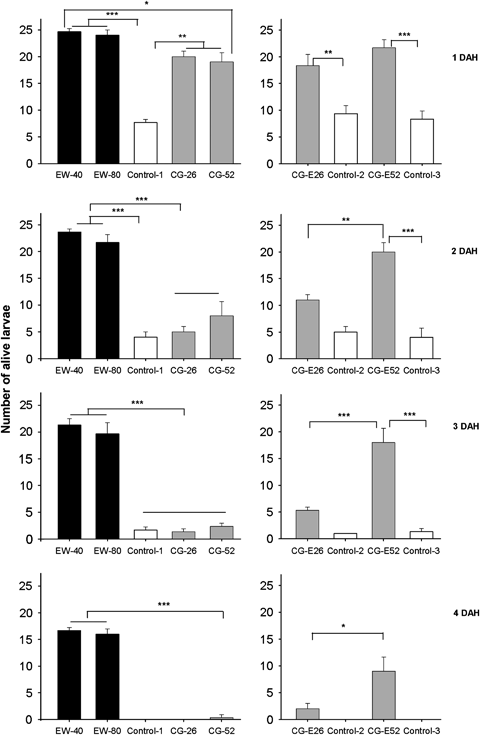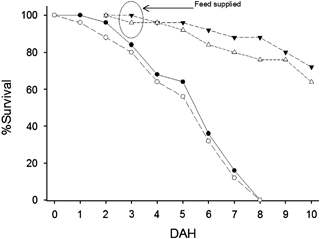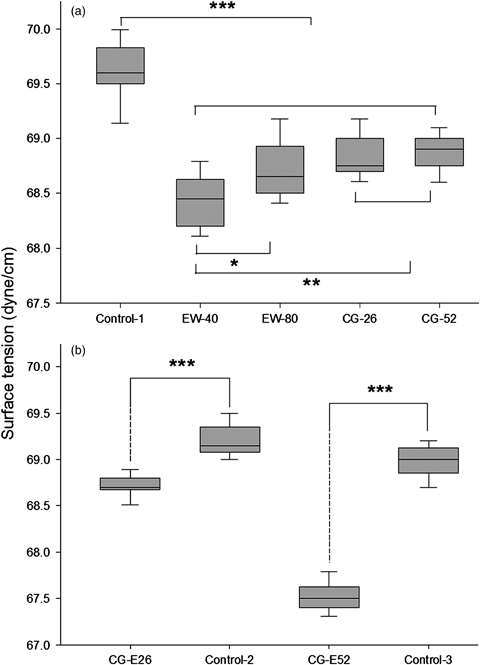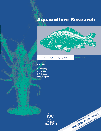Prevention of surface death of horse mackerel (Trachurus mediterraneus) larvae by the addition of egg white and camphor grain to rearing water
Abstract
To prevent surface tension-related deaths in horse mackerel larvae, Trachurus mediterraneus, camphor grain (CG; 26 and 52 mg L−1 with and without ethanol) and chicken egg white (EW; 40 and 80 μL L−1) were added to rearing water. Compared with the control groups, supplementation of EW (40–80 μL) and CG (52 mg L−1, dissolved in ethanol) significantly improved the survivals of horse mackerel larvae (P<0.05). At the end of the 10 days after hatching, the survival rates of EW-40 and EW-80 were 64% and 72% respectively. No clear correlation was found between surface tension and survival rate.
Introduction
Early larval period is a very critical stage in marine fish and serious species-specific mortalities may occur during this stage. These kind of larval deaths have been attributed to originate the physical stresses such as water surface tension and light intensity. Water surface tension may be responsible for surface deaths in a variety of marine fish larvae during the early larval stage (Yamaoka, Nanbu, Miyagawa, Isshiki & Kusaka 2000; Kaji, Kodama, Arai, Tanaka & Tagawa 2003; Tagawa, Kaji, Kinoshita & Tanaka 2004). Furthermore, water surface tension was found to be a key environmental factor in the occurrence of surface deaths (Yamaoka et al. 2000). Large numbers of dead larvae were frequently observed on the water surface (Kaji et al. 2003) because mucus secreted from larvae acts as a glue when larvae swim up and touch the water surface (Yamaoka et al. 2000).
Although it has been suggested that surface death was closely related to water surface tension, the relationship between them has not been clearly proven. To prevent this problem, the use of an oil film (Yamaoka et al. 2000), a physical technique (Sakakura, Shiotani, Shiozaki & Hagiwara 2007) and chicken egg white (EW) (Kaji et al. 2003) has been studied in a few marine fish larvae (striped bonito, Sarda orientalis, Pez cochero, Dules auriga, red-spotted grouper, Epinephelus akaara). On the other hand, there are difficulties in removing the oil from the rearing water and this would give rise to the latter survival problems (Kitajima, Tsukashima, Fujita, Watanabe & Yone 1981; Howell, Day, Ellis & Baynes 1998). The physical technique requires comprehensive knowledge to set the oscillation distance and period. However, in mass larviculture tanks, it may be difficult to maintain this kind of system. The disadvantage of using chicken EW is the fermentation of the dissolved EW, which decreases water quality (Kaji et al. 2003).
Besides being commercially important for Black Sea Fisheries, horse mackerel is a strong candidate for aquaculture and there has not been any study related to larval survival and rearing. During the preliminary study of the starvation tolerance of horse mackerel, Trachurus trachurus, larvae in rearing experiments, no larvae survived 4 days after hatching (unpublished data). Therefore, it is important to be aware of early larval problems of horse mackerel. The objectives of the present study were to determine the effects of camphor grains (CG) and chicken EW on the survival of horse mackerel larvae and to determine the relationship between survival and surface tension of the water. Surfactants such as CG that may be alternatives to these have been tried. Camphor grain is a natural surfactant obtained from the Cinnamomum camphora tree commonly known as the Camphor tree.
Material and methods
Field study
Horse mackerel egg samplings were carried out at dawn under favourable weather and sea conditions in June on the Camburnu coast of the Black Sea (40°55′04″N, 40°10′41″E). Eggs were sampled by horizontal towing of a Hensen-type plankton net with a 500 μm mesh size at a speed of 1.5–2 knots. Eggs were collected either on the water surface or within 50 cm of the surface for 10 min. Samples in the net were transferred to 1 L plastic holding containers and transported to the laboratory within 2 h after sampling.
Fish eggs and hatching
The samples were filtered using 1000 and 500 μm size filter equipment, respectively, and the filtered samples were then transferred into the petri plaques. Eggs were selected and sorted under stereo and light microscopy. Only buoyant eggs were sorted based on their species according to Dekhnik (1973), Russell (1976), Moser (1983), Yuksek and Gucu (1994), Mater and Coker (2002) and Coker (2003) and they were hatched in 1 L of glass beakers. After hatching, the larvae were also examined to determine whether they were horse mackerel or not (Mater and Coker 2002; Coker 2003). Larvae were counted and transferred into 80 mL plastic containers that contained filtered (10 μm) and UV-treated sea water. During the experiment, water temperature and salinity were 21 ± 0.3 °C and 17.3 ± 0.2‰ respectively.
Preparing of experimental media and the controls
This experiment was conducted at Karadeniz Technical University, Faculty of Marine Science Plankton Laboratory. The EW was prepared using a slightly modified method described by Kaji et al. (2003). Briefly, after separating EW from the egg yolk, EW and sea water (1:49) were mixed into a 50 mL falcon tube and centrifuged at 2000 × g for 3 min and the mixture was left for 8 h at 4 °C to collapse the foam before adding to rearing water. Egg white was added to each experimental container for a final concentration of 40 and 80 μL L−1 and triplicate containers were designated for each concentration. An equivalent volume of sea water (without EW) was added to the control containers.
Fifty millilitre of sea water was mixed with 0.46 g of CG and vortexed and left 1 day at 4 °C. Then the solution was added to the experimental containers for a final concentration of 0.26 mg (CG-26) and 0.52 mg (CG-52) CG/L. As GC is insoluble in water, it was dissolved in absolute ethanol and then 0.25 and 0.5 mL of dissolved CG were added to the experimental containers to attain final concentrations of 26 mg (CG-E26) and 52 mg (CG-E52) CG/L. An equivalent volume of ethanol (without CG) was added to the control containers. Triplicate containers were designated for each concentration.
Eggs were incubated in 1 L glass containers without aeration. After hatching, larvae from one of the 1 L hatching containers were randomly transferred to one of 27 rearing containers containing 80 mL of static rearing water (25 larvae per container). During the experiment, rearing water was not renewed, aerated and no food was added. Sea water used in the experiment was assured from natural filtered and UV-treated sea water. Light intensity was adjusted as 2000 lx; the light source was mounted 60 cm above the water surface. The natural photoperiod was used (16:00 hours light and 8:00 hours dark). These experiments lasted for 8 days after hatching.
Another experiment was set up to determine the effects of EW to fed larvae. For this purpose, the experiment for the EW-40 and EW-80 groups was conducted as explained above and larvae were fed with Brachionus rotundiformis at a density of 15–20 individuals mL−1 after 3 days of hatching (DAH), when eye pigmentation occurred and the mouth opened. Organic waste and dead rotifer was removed daily from the bottom of the container by siphoning while one-third of the rearing water was exchanged. This experiment lasted 10 DAH.
Collection of dead larvae
Because enzymatic activity is high during the larval period, dead larvae were self-digested within a couple of hours; therefore, it was difficult to distinguish dead larvae with the naked eye. In the preliminary study, it was very difficult to distinguish very small sizes of dead and live larvae from the 1 L container with the naked eye. To solve this problem, 80 mL solid plastic rearing containers that could fit into a stereo microscope was used and dead larvae were collected at 24-h intervals. Therefore, possible mistakes related to counting of dead larvae were eliminated.
Surface tension measurement
All experimental media were filtered and kept at 21 °C until they reached thermal equilibrium. Then surface tensions were measured using Tensiometer AquaPi (Krűss,Hamburg, Germany).
Statistical analysis
During the 10 days of the experiment, the survival of fish was analysed using the Fisher exact test. (sigmaplot, Systat Software, San Jose, CA, USA). The differences between surface tensions of the water were compared using a t-test.
Results
The swimming behaviour of the larvae was different between 1 DAH and the other days. On 0, 2 and 3 DAH, it was observed that larvae in all groups swam upward to the water surface after the transfer, while this kind of swimming was not observed on 1 DAH. When the larvae touched the water surface on 0, 2 and 3 DAH, some larvae were trapped by the water surface and died in the control group, while no larvae were trapped by the water surface in the EW- and CG-supplemented groups.
When horse mackerel eggs were collected, sorted and transferred to 1 L beakers, they hatched within 6–10 h. After transferring yolk sac larvae to 80 mL containers with or without EW and CG, on 1, 2 and 3 DAH, the number of surviving larvae was constantly and significantly higher (P<0.01) in the EW groups and the CG-E52 group than in the control (Fig. 1). Survival of the larvae was not affected by CG-26 compared with the control group. On 4 DAH, there was no larva left in the control group, while the survival rates of the EW-40, EW-80 and CG-52 groups were 64%, 68% and 36% respectively. Larvae in all groups were dead on 8 DAH because of the starving.

Number of surviving larva (mean ± SEM) in the control groups and the related experimental rearing containers on 1–4 days (n: 3). Egg white was added to each experimental container to a final concentration of 40 and 80 μL L−1. An equivalent volume of sea water (without EW) was added to the control containers. Camphor grain was added to the experimental containers to reach final concentration of 26 mg (CG-E26) and 52 mg (CG-E52) CG/L. An equivalent volume of ethanol (without CG) was added to the control containers. *P<0.05, **P<0.01, ***P<0.001.
Chicken EW-treated larvae were fed with Brachionus roduntiformes when eye pigmentation appeared on 3 DAH. As few larvae were left in the control group during eye pigmentation, a control group was not established. Therefore, instead of the control group, the EW-supplemented but unfed group was used as a control group and compared with the EW-supplemented and fed groups. Egg white was not added to the fed groups after 6 DAH. The survival of the EW-supplemented and fed group was significantly higher (P<0.01) than the unfed EW groups. The experiment was completed 10 DAH because all the unfed control groups were dead on 8 DAH. At the end of the 10 DAH, the survival rates of EW-40 and EW-80 were 64% and 72% respectively (Fig. 2).

Survival rates in fed and unfed groups of different concentrations of the EW supplement. EW-40 (•), EW-80 (○), EW-Fed80 (▾), EW-Fed40 (Δ).
When CG was added to sea water, it did not dissolve uniformly and its surfactant effect was lower than those dissolved in ethanol. The supplementation of 40 μL EW was slightly more effective than that of 80 μL EW in decreasing the surface tension. Camphor grain (52 mg L−1, dissolved in ethanol) supplementation reduced the surface tension to 67.5 dyne cm−1. This value was the most effective among experimental media (Fig. 3).

Box plots of the surface tensions of experimental and the control media (n: 10) by t-test by sigmaplot 11.0. (a) Control 1 (only sea water) and related experimental media, (b) CG dissolved in ethanol and the equivalent ethanol controls. *P<0.05, **P<0.01, ***P<0.001.
Lowering surface tension tended to increase the survival, but the relationship between surface tension and survival rate was not significant (P>0.05). Although the most effective surfactant value was measured on CG-E52, the survival in this group was similar to the EW-40 and EW-80 groups until 4 DAH (1, 3), but in the subsequent days, the survival in CG-E52 decreased. These results showed that there was no clear correlation between surface tension and survival rate.
Discussion
There still remain unknown factors related to survival during the early larval stage of many marine fish, while further requirements after the larval stage have been better known. There are two crucial stages during early larval life. The first is the yolk sac stage in which serious mortality occurs depending on the species and the second is the first feeding stage. Surface tension-related death has been indicated as an important survival factor; even Yamaoka et al. (2000) defined surface tension as a ‘key factor’. Until the first intake of air, larva secretes mucous, which acts as a glue. Surface death occurs due to a mismatch of mucous cells and surface tension of the water (Yamaoka et al. 2000). The original function of mucous cells might be that of an antipredator (Kaji, Yamaoka, Isshiki & Yamada 1995). In natural environments, phytoplankton breakdown acts as a surfactant. At the same time, natural sea environments are not static but different currents take place each time. These currents prevent larvae from trapping. Yamaoka et al. (2000) stated that the water current was suggested to help fish caught by the water surface to free them from the water surface. Initial inflation of the swim bladder was experimentally inhibited by covering the water surface with mineral oil, which blocked the access of larvae to the surface; therefore, lordotic deformity may occur. Apart from the present study, larvae were reared for 15 days in the presence of EW and CG-E52 and no lordotic deformity was observed (data not shown). Therefore, there is no need to remove EW and CG from the rearing water at the time of initial inflation of the swim bladder in massive larval production.
Horse mackerel larvae swim upward to the water surface after hatching and stay here up to 24 h and then swim downward. Although there is a positive effect of EW on larval survival, it has been unclear whether this is due to the surfactant effect of EW or not (Kaji et al. 2003). In contrast to the study of Kaji et al. (2003), there was few trapped larva on the water surface, although several deaths occurred in the control groups in the present study. When larvae were transferred to transparent containers with only seawater, some dead larvae were seen sticking to the wall and the bottom of the container. Egg white and CG supplementation drastically reduced the deaths related to trapping compared with the control group.
Black Sea has a range of salinity of approximately 17–18‰ and it is defined as brackish water rather than sea water. The surface tension of Black Sea was determined to be around 69.6 dynes cm−1 at 21 °C. Experimental sea water had 69.5 dynes cm−1 surface tension at 21 °C. Initial studies were conducted with normal sea water, which had salinities above 30‰. Their surface tensions can also be different from the present experimental sea water. Therefore, the same supplementation of EW and CG in the sea water with different salinities may lead to differences in the surface tension.
Deaths occurred not only on the water surface but on the walls of the containers in all the control group containers. Previous studies did not report that larvae could stick to the container wall and bottom. This kind of deaths should be carefully considered because it may cause miscounting of dead larvae.
Because of fermentation of EW within a short period of time, CG may be an alternative way to decrease surface tension-related surface deaths. CG shows oscillatory motion along the water surface and causes a rhythmic change in the surface tension when added as a grain. When dissolved in ethanol, CG creates a camphor layer on the water surface with time. But the effects on fish larvae or juvenile fish are unknown. Although surface tension of the water was significantly reduced by supplementation of EW and GC compared with control water surface tension, the survival of larvae was not directly related to surface tension. CG-52 showed survival similar to those in EW until 3 DAH, but the positive effect of EW remained during the subsequent days, while the survival in the CG-52 group decreased. Therefore, survival may depend not only on surface tension but also unknown beneficial factors. A mixture of EW and CG may be more effective, because of the strong surfactant effect of CG and the unknown beneficial effects of EW.
Acknowledgments
This study was supported by grants from the TUBITAK (Project no: 110O050). We thank Mrs Filiz TOPLU for measuring the surface tension of the solutions.




